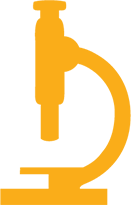20 Minute Labs: Color Storm in a Glass

MAKE IT RAIN IN COLOR!
Is it starting to get rainy where you live? Sometimes it can feel gray and dreary. What would be like if it rained in colors? Let's bring some color to our winter with some fun indoor science!
If you've ever added food coloring to water, you probably noticed that the ribbons of color quickly mix into the water creating a uniform color. In this month's 20 Minute Lab, we'll use the scientific concept of density to preserve those beautiful ribbons of colors for longer!

WHAT YOU'LL NEED
- tall clear glass or wide-brimmed vase
(the taller the better!) - water to fill the glass
- small jar
- 1/4 cup canola oil
- food coloring (multiple colors)
- stir stick or long spoon
LET'S GET STARTED!
Pre-experiment:
To see what food coloring looks like in water only (with no oil), fill a glass with water and add some food coloring drop by drop. Observe what happens. Set aside and use clean, dry materials for the experiment.
Experiment:
- Fill your glass or vase with water, leaving about and inch and a half of space at the top. Set aside.
- To the jar, add 1/4 cup canola or vegetable oil.
-
To the oil, add four drops of food coloring per color (we used yellow, red, blue and green). Note: Don't let this sit too long or the the food coloring drops will eventually find each other, mix together, and become one color.

-
Stir the food coloring and oil with the stir stick vigorously. The food coloring should be broken up into many tiny droplets.

- Now pour the oil into the glass or vase of water.
- Wait for the oil to settle into a layer on the top, then observe what happens!
WHAT'S GOING ON?
Did you see beautiful strands of raining colors! Why does this happen? Why is it different than what happens with food coloring in water without oil?

Food coloring is an aqueous solution. This means that the main ingredient is water.
As you noticed when you added food coloring to the oil in the jar, oil and water do not mix! The droplets of food coloring stayed suspended in the oil without mixing and changing the oil's color.
Even when you stirred the mixture vigorously, the food coloring only broke up into smaller, separated droplets.

When droplets do not combine when mixed together like this, that is, when they are not soluble in a liquid - the mixture is called an emulsion.
Water doesn't mix with oil because oil is made of 'hydrophobic', or water-fearing, molecules that are not soluble in water. You saw this in action when you poured the oil into the glass of water and all the oil bounced right up to form a separate layer on the top!

Water is denser than oil, so it stays at the bottom. Density refers to how much stuff can be packed in a given space. Liquids packed with smaller molecules, like water, are more dense and sink toward the bottom. Liquids made up of larger molecules, like oil, are less dense and sit on top.
Because food coloring is essentially water, it eventually sinks through to the bottom of the oil layer and enters the column of water, resulting in the beautiful color storm you observed!
SHARE WITH US!
Let us know how your experiments turned out! Share your photos and results with us on Facebook, Twitter, Instagram, or send us an email to info@yellow-scope.com. We love getting your messages!
For more exciting experiments, check out our Yellow Scope science kits on the Shop tab of our website!



Chelsea Schuyler
Author